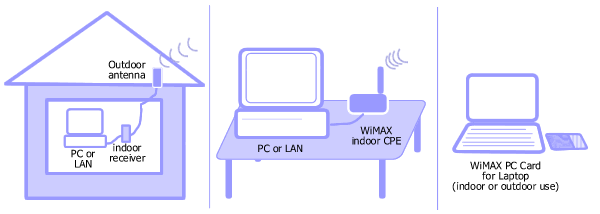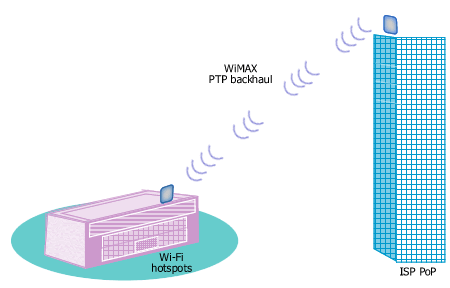Internet Access Guide : WiMAX

Picture: Fixed and Mobile WiMAX CPE
Outdoor CPE, indoor CPE, and PC card.
WiMAX is a versatile wireless MAN (Metropolitan Area Network) access technology that can
address diverse applications. Fixed WiMAX most notably will become
an alternative for DSL or cable broadband access. That's why sometimes WiMAX is called Wireless DSL.
For that kind of application, user will need outdoor or indoor CPE
which consists of antenna, RF interface, modem, and various
interfaces for connecting user devices. CPE with roof-mounted or
wall-mounted outdoor antenna offers the best performance of all,
but in many cases its installation requires a technician and maybe
a truckroll.
High end Fixed WiMAX CPEs
integrate several functions in one box which is ready for home or
small office networking
and Internet connection sharing. The kinds of interfaces for
connecting computers and other types of user devices are RJ-45
(Ethernet/Fast Ethernet), RJ-11 (POTS), RJ-11 with integrated VoIP adapter, router, LAN
switch, and
even Wi-Fi access point.

Picture: WiMAX Point-To-Point (PTP) backhaul
In point-to-point application, WiMAX serves as a big pipe
that streams Wi-Fi hotspot traffic to/from the Internet.
Fixed WiMAX also finds its application as
backhaul (high speed connection to the Central Office or ISP's
Point of Presence) for Wi-Fi
hotspots, cellular base stations connection to base station
controller, and backbone for proprietary
networks spanning hard-to-wire geographical areas. A more
interesting application of Fixed WiMAX is as wireless access in a hotzone
or metro zone, that's the kind of hotspot but covers larger area
(very often city-wide). In this particular case, WiMAX can be
viewed as a
competitor to Wi-Fi because it could replace Wi-Fi altogether.
Nonetheless, in the near future both technologies will work
together in a complementary manner. More details on
this page.
Meanwhile, Mobile WiMAX will bring broadband access experience to
stationary as well as walking users
and those traveling at vehicular speed (up to about 120 km/hour) with devices such as laptop, PDA, and smart phone.
At a glance, this is like a typical application of 3G. But Mobile
WiMAX introduces several advantages in that it has higher
spectral efficiency, better
support for NLOS technologies,
flexible and dynamic QoS, and corporate-grade
security, thanks to the
OFDM/OFDMA PHY
and the advanced MAC design. So instead, in terms of services
Mobile WiMAX
is better compared with DSL with the bonus of mobility. Expect
these kinds of services over Mobile WiMAX: music/video streaming,
live TV broadcast, voice/video chatting, Internet multiplayer game, large
file download/upload from/to the Internet, remote access to
office LAN via VPN. Mobile WiMAX vision as a Personal Broadband is
to make broadband available everywhere (i.e. at home, in the
office, on the street, on car, on train, on vessel).
|